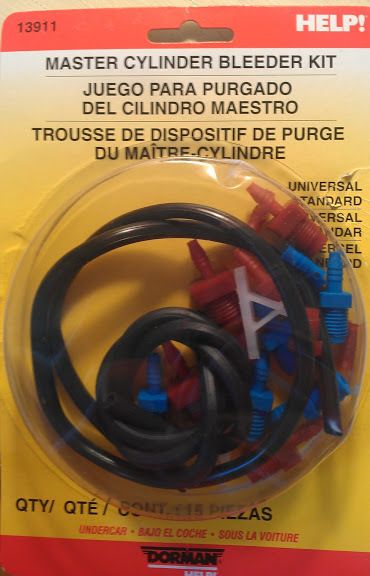bleeding clutch cylinders
9353 views
35 replies
9 following

bleeding clutch cylinders

lydia
+1y
I'm replacing the clutch cylinders and hoses and I finally got them out of the truck and they are sitting on my work bench. (it only took me 6 months. I'm a slow worker.)
I've heard a lot of advice saying to bench bleed the new cyls before installing because if you try to bleed them on the truck, you'll never get the air out. The instructions that came with the cyls say to bleed the usual way (using bleeder valve on slave with a partner pushing the clutch pedal) and so do the instructions in the chiltons.
Neither of the cyls came a with a "bench bleeder kit" which I've heard peeps talking about.
So, can anyone break it down for me? If it just takes longer, I'd rather bleed them on the truck. But if bench bleeding is absolutely necessary, I can try to find some hoses or a kit or whatever the heck you need.
I've heard a lot of advice saying to bench bleed the new cyls before installing because if you try to bleed them on the truck, you'll never get the air out. The instructions that came with the cyls say to bleed the usual way (using bleeder valve on slave with a partner pushing the clutch pedal) and so do the instructions in the chiltons.
Neither of the cyls came a with a "bench bleeder kit" which I've heard peeps talking about.
So, can anyone break it down for me? If it just takes longer, I'd rather bleed them on the truck. But if bench bleeding is absolutely necessary, I can try to find some hoses or a kit or whatever the heck you need.

simoniz
+1y
I did mine mounted on my truck last month, and switched the whole system out in one session. I used a MityVac brake bleeder and did it on my own with that. Nothing was bench bled, I drained the old fluid with the MityVac attached to the slave unit underneath (with everything securely jacked up, of course), then unbolted it all, bolted up the new stuff, filled the clutch fluid reservoir, and then got underneath again and bled out the fluid by pumping the MityVac, alternating with tightening up the bleed nipple, then releasing it and letting the MityVac suck the fluid through the line. Once I had clear fluid coming through with no bubbles, I tightened up the nipple, went up top and pumped the clutch pedal a few times, and I had pressure. As long as you keep an eye on the fluid level in the reservoir, you can do it too. It's a bit of "up and down" as you switch position from the under the truck with the slave unit and back up to pump the pedal a few times, but nothing major.
Get a MityVac at any auto parts store. I use it on the brakes on all my old motorbikes too, and it speeds up the job no end. Also, some flare wrenches make it easier working on the brake line nuts, so get a set - spray them with PB Blaster the day before to loosen them up.
btw, is that a Honda 250 in your profile pic?
Get a MityVac at any auto parts store. I use it on the brakes on all my old motorbikes too, and it speeds up the job no end. Also, some flare wrenches make it easier working on the brake line nuts, so get a set - spray them with PB Blaster the day before to loosen them up.
btw, is that a Honda 250 in your profile pic?

Cusser
+1y
Lydia:
I'd be surprised if NAPA or CarQuest doesn't stock them. I'm sure some cylinders actually came with the bleeding accessories in the package, and I've saved those.
You can technically "bench bleed" in the truck, just do it before you attach the steel fluid line to the clutch master cylinder. The kit is utilized so that on the "up" stroke that the clutch master sucks fluid back in, instead of air.
I'd be surprised if NAPA or CarQuest doesn't stock them. I'm sure some cylinders actually came with the bleeding accessories in the package, and I've saved those.
You can technically "bench bleed" in the truck, just do it before you attach the steel fluid line to the clutch master cylinder. The kit is utilized so that on the "up" stroke that the clutch master sucks fluid back in, instead of air.
G
gregfarz78
+1y
I bleed my clutch master when it was mounted on the truck its easier that way...just get that kit that cusser posted thats all you really need. The clutch slave the best way is find someone to press the pedal and you crawl under and crack the bleeder valve, rinse and repeat a few times till the pedal gets stiff. I tried one of those mitty vac kits thing was a waste of money and didnt work like it said it should.

lydia
+1y
Okay thank you - that makes total sense. Ordered the kit, will bleed master once it's mounted in the truck, and then will get mr. lydia to pump the clutch and keep an eye on the reservoir while I crack the bleeder valve.
Simoniz - I did get the flare wrenches and I am super glad I did - they were on there tight and you could see how soft those flare nuts were because they got pretty dinged up just from the loosening/tightening I did to replace the hoses. I sprayed them with wd-40 and let that sit for a few hours - have never tried pb blaster. RE the bike in my avatar, you are close - it's a '80 cm400t.
Simoniz - I did get the flare wrenches and I am super glad I did - they were on there tight and you could see how soft those flare nuts were because they got pretty dinged up just from the loosening/tightening I did to replace the hoses. I sprayed them with wd-40 and let that sit for a few hours - have never tried pb blaster. RE the bike in my avatar, you are close - it's a '80 cm400t.

axel breaker earl
+1y
Yes, bleed them when they are mounted in/on the truck.......the reason I say this is, I have bench bled one of the master brake cylinders before and apparently you can push the plunger in too far and rupture the plunger seal......and your new master cylinder will not build enough pressure to operate the wheel cylinders/calipers as it should......I learned this the hard way, then I read the included instructions and found out you aren't supposed to do bench bleeding on that particular master cylinder! Hey, what can I say......I'm a guy......we don't read instructions......before hand anyway!
Of course, growing up and working on domestic vehicles, back in the day, we ALWAYS bench bled a master cylinder before installing it in the vehicle!! The clutches were mechanical linkage too, so no bleeding that!

Cusser
+1y
Right, the flare wrenches are great, and really essential, for initial loosening and final tightening of such flare fittings.
Too many instances of additional problems that happened when someone tried to "get by" using inappropriate tools or trying to be cheap abound on the Internet !!!
Remember - for "our" occasional use, all tools do not need to be Snap-On or Sears Craftsman type quality.
I've even purchased used sockets up north for 50 cents each from a place called (really) Panhandle Randall's to add on to the inexpensive set I carry in my 2004 Frontier.
Too many instances of additional problems that happened when someone tried to "get by" using inappropriate tools or trying to be cheap abound on the Internet !!!
Remember - for "our" occasional use, all tools do not need to be Snap-On or Sears Craftsman type quality.
I've even purchased used sockets up north for 50 cents each from a place called (really) Panhandle Randall's to add on to the inexpensive set I carry in my 2004 Frontier.

lydia
+1y
Okay got the kit in the mail, looks like so:

I like how it says HELP! on the package... heh.
Now if I can just get it to stop raining for a few hours tomorrow, I'm all set.

I like how it says HELP! on the package... heh.
Now if I can just get it to stop raining for a few hours tomorrow, I'm all set.

Cusser
+1y
Yep, there's not much to the kit, but different threaded adapters in several metric and several SAE sizes, plus tubing, plus holders to maintain the tubes from those adapters in the brake fluid inside the clutch master's reservoir. There will be multiples so that it woill be applicable to brake master cylinders as well.
I can't remember, so take an 8mm and a 10mm box or combination wrench, a piece of tubing, and a jar under the truck with you when you finish the bench bleeding and attach the fluid line, that you don't have to make multiple trips down under. Use a vacuum cap on the clutch bleed screw when finished if you don't have a genuine rubber cap for it.
I can't remember, so take an 8mm and a 10mm box or combination wrench, a piece of tubing, and a jar under the truck with you when you finish the bench bleeding and attach the fluid line, that you don't have to make multiple trips down under. Use a vacuum cap on the clutch bleed screw when finished if you don't have a genuine rubber cap for it.

lydia
+1y
Wellllllll I put the master back in the truck, hooked up the bleeder kit, and had my guy push the clutch pedal slowly down and watched the bubbles... but I think something's not right. The clutch pedal goes to the floor with almost no resistance and stays there, it has to be popped back out.
Is this what's supposed to be happening?
Is this what's supposed to be happening?
Related Discussions in Mazda Engine General
Thread
Posts
Last Post

